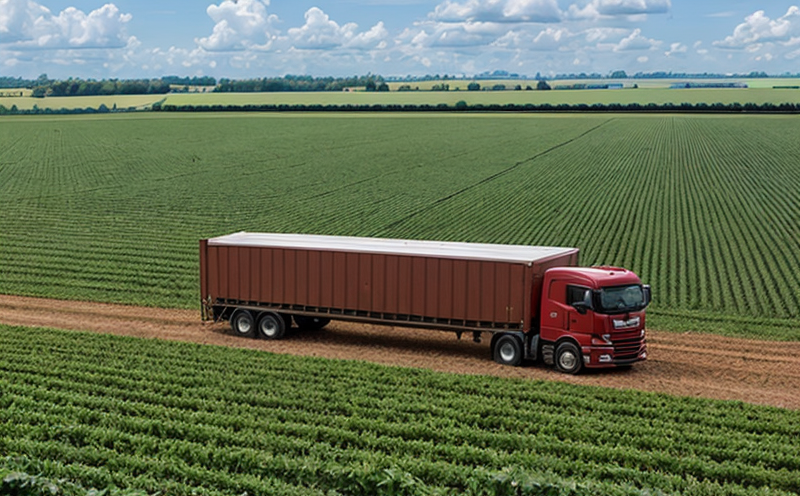Stackability Testing of Agricultural Crates
The integrity and functionality of packaging used in agriculture are critical to ensuring safe transportation and delivery of goods. Stackability testing is a vital component of this process, as it ensures that crates can be safely stacked for transport without compromising their structural integrity or the quality of the agricultural goods they contain.
Stackability tests involve simulating real-world stacking conditions to determine how many units of a crate type can be safely and effectively placed on top of each other. This testing is particularly important in agriculture, where crates are often stacked for long periods during transport from farms to markets or processing facilities. The test aims to identify any potential weaknesses in the design that could lead to damage, collapse, or contamination of goods.
The process begins with selecting a sample crate, typically one that represents the majority of units produced by the manufacturer. The crate is then placed on a platform designed to simulate the stacking environment. Additional crates are added incrementally until either structural failure occurs or the maximum safe stack height is reached. During testing, engineers carefully monitor the weight distribution and stability of each layer.
For accurate results, it is crucial that the test conditions closely mimic actual transport scenarios. This includes using the appropriate stacking weights and ensuring that environmental factors like temperature and humidity are controlled to reflect real-world conditions. The use of high-quality materials in both the crate design and the testing equipment ensures reliable and repeatable results.
Once the stack reaches its maximum height, engineers conduct a thorough inspection for any signs of structural damage or deformation. If the test passes, it confirms that the crate can safely be stacked without risk of collapse during transport. In cases where the test fails, modifications to the design may be necessary to ensure compliance with industry standards and regulations.
Stackability tests are often conducted in accordance with international standards such as ISO 15379-2:2014 for packaging drop tests and ISO 6853:2018 for stack load testing. Compliance with these standards ensures that the crates meet global quality and safety requirements, facilitating easier trade between countries.
In summary, stackability testing of agricultural crates is a critical process in ensuring the safe transport and delivery of goods. By simulating real-world stacking conditions, this test helps identify potential weaknesses in crate design and materials, thereby enhancing product integrity and customer satisfaction.
Applied Standards
The stackability testing of agricultural crates is governed by several international standards that ensure the safety and quality of packaging used in transportation. The primary standard for this type of test is ISO 6853:2018, which provides guidelines on determining the stacking load capacity of packaging containers.
- ISO 6853:2018: This standard specifies methods for determining the stacking load capacity and stability of packaging containers. It outlines the procedures for testing the maximum weight a stack of crates can bear without collapsing or deforming significantly.
- ASTM D4741-96: While not specifically focused on agricultural crates, ASTM standards are widely recognized in North America. This particular standard deals with the determination of the stacking load capacity of plastic containers and provides similar guidelines to ISO 6853:2018.
- EN 12878: This European standard covers the design and testing of reusable packaging systems, including those used in agriculture. It ensures that crates are durable and can withstand repeated use without compromising safety or quality.
These standards provide a framework for conducting stackability tests, ensuring that the results are consistent and reliable across different regions and industries.
Eurolab Advantages
At Eurolab, we pride ourselves on offering comprehensive testing services tailored to meet the specific needs of the agricultural sector. Our expertise in packaging and transport simulation for agricultural goods is unmatched, providing our clients with accurate and reliable stackability test results.
We employ state-of-the-art equipment that ensures precise and repeatable test conditions, allowing us to accurately simulate real-world stacking scenarios. Our team of experienced engineers can provide detailed analysis and recommendations based on the test results, helping manufacturers optimize their crate designs for both safety and efficiency.
Our commitment to quality is reflected in our adherence to international standards such as ISO 6853:2018 and ASTM D4741-96. We ensure that all tests are conducted in a controlled environment, using calibrated equipment to maintain consistent results. Our clients can trust us to deliver accurate test data that will help them meet regulatory requirements and enhance product quality.
Moreover, Eurolab offers additional services such as materials testing, dimensional analysis, and environmental stress simulation. These complementary tests provide a holistic view of the crate's performance under various conditions, ensuring that our clients have all the information they need to make informed decisions.
By choosing Eurolab for your stackability testing needs, you can be confident in the quality and accuracy of the results. Our expertise and commitment to excellence will help ensure that your agricultural crates meet the highest standards of safety and reliability.





